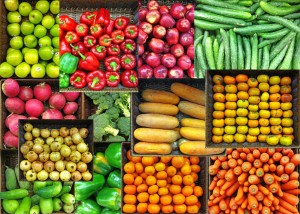Interested in Eating Organic? START with FRESH!
 “I want to eat healthy, fresh or organic foods, but I can’t afford it.” On a scale of 1 to 10, how true do you believe that statement to be for you and your family? Though there is some validity to fresh or organic fare being more expensive, it’s not as expensive as you might think. In fact, seemingly convenient food choices might be saving your wallet temporarily, but could add up to major medical costs down the line or to a growing waistline because our bodies simply aren’t designed to recognize and effectively process the many synthetic ingredients we put into them with these “quick and easy foods.”
“I want to eat healthy, fresh or organic foods, but I can’t afford it.” On a scale of 1 to 10, how true do you believe that statement to be for you and your family? Though there is some validity to fresh or organic fare being more expensive, it’s not as expensive as you might think. In fact, seemingly convenient food choices might be saving your wallet temporarily, but could add up to major medical costs down the line or to a growing waistline because our bodies simply aren’t designed to recognize and effectively process the many synthetic ingredients we put into them with these “quick and easy foods.”
There are a lot of myths surrounding the cost of fresh foods, leaving many people feeling like their budgets just won’t stretch that far. But buying fresh(er) foods can actually be more affordable than you might think.
Between rushing to soccer games, school functions, or squeezing in 40+ hours of work each week, chances are most families are stretched thin for time, patience and energy. So start with some small, conscious efforts and over time, your family could be eating better and feeling healthier in the process.
Some favorite “fresh fare” tips:
1. Plan ahead.Before you ever enter a grocery store, do your homework. Research some easy and fresh swaps for the convenience foods your family eats most. Ask friends, co-workers or locals where to pick up great fresh food at a reasonable price.
2. Start small.Instead of changing out and throwing away the entire contents of your refrigerator or pantry, pick one thing to change at a time. If you run out of an ingredient, buy its “fresh” counterpart at the store the next time around.
3. Make a menu for the week and stick to it. By pre-planning your meals you can often eliminate the impulse, “pressed for time” purchases. You can then anticipate how much a grocery store trip will cost with fresh ingredients included.
4. Try different stores. Different stores run different specials on items each week, and some stores can have better produce than others. By knowing what’s available, you can better assess where to pick up fruits and veggies vs. meats or dairy. Big warehouse stores like Costco may also be cheaper to buy fresh ingredients in bulk and you can freeze unused portions for a later date.
5. Shop the perimeters of the store. Most grocery stores place the perishable, whole food items on the outer perimeters of the store (e.g. produce, dairy, eggs and meats). By sticking to the outskirts of the store, you can ensure your family is sticking to the fresher basic necessities.
6. Try farmers markets. Research local farmer markets in your area. Produce can be seasonal, cheaper and most are locally grown.
7. Cook from scratch. Not only is it healthier since you can choose the ingredients going into your meal, but it will also be easier on the wallet by not having to pay for restaurant or pre-made mark-ups.
8. Grow your own produce.Even if you think you don’t have the space for a full garden, choose one item that you and your family consume regularly, and research how to grow it in space you have available. Can it grow in a pot? Indoors? By taking a trip to a local nursery, someone can help you figure out a way to make it grow.
Whether you start with several changes or one small change at a time, the idea is that fresh fare is attainable, reasonably priced and available. Every step toward a better diet full of fresh fruits and vegetables will help your waistline and bottom line.






